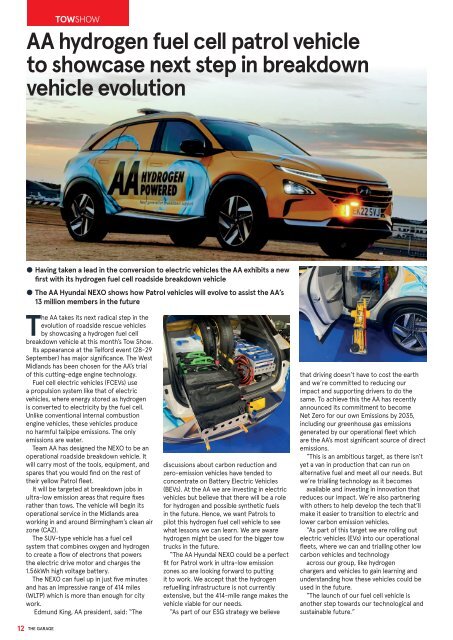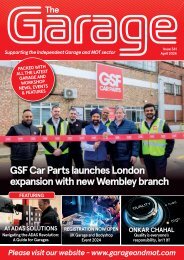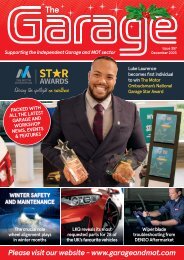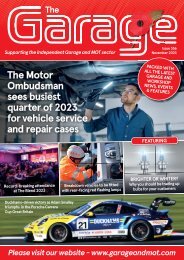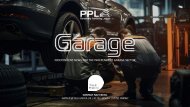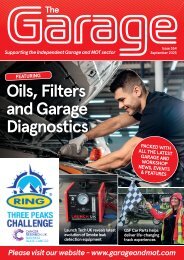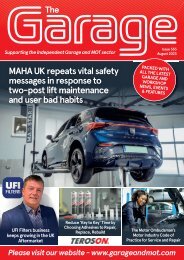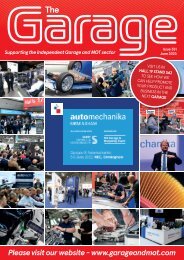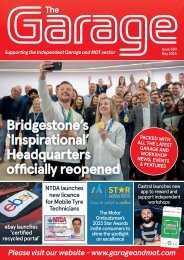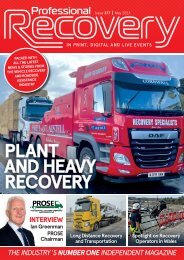Create successful ePaper yourself
Turn your PDF publications into a flip-book with our unique Google optimized e-Paper software.
TOWSHOW<br />
AA hydrogen fuel cell patrol vehicle<br />
to showcase next step in breakdown<br />
vehicle evolution<br />
● Having taken a lead in the conversion to electric vehicles the AA exhibits a new<br />
first with its hydrogen fuel cell roadside breakdown vehicle<br />
● <strong>The</strong> AA Hyundai NEXO shows how Patrol vehicles will evolve to assist the AA’s<br />
13 million members in the future<br />
<strong>The</strong> AA takes its next radical step in the<br />
evolution of roadside rescue vehicles<br />
by showcasing a hydrogen fuel cell<br />
breakdown vehicle at this month’s Tow Show.<br />
Its appearance at the Telford event (28-29<br />
September) has major significance. <strong>The</strong> West<br />
Midlands has been chosen for the AA’s trial<br />
of this cutting-edge engine technology.<br />
Fuel cell electric vehicles (FCEVs) use<br />
a propulsion system like that of electric<br />
vehicles, where energy stored as hydrogen<br />
is converted to electricity by the fuel cell.<br />
Unlike conventional internal combustion<br />
engine vehicles, these vehicles produce<br />
no harmful tailpipe emissions. <strong>The</strong> only<br />
emissions are water.<br />
Team AA has designed the NEXO to be an<br />
operational roadside breakdown vehicle. It<br />
will carry most of the tools, equipment, and<br />
spares that you would find on the rest of<br />
their yellow Patrol fleet.<br />
It will be targeted at breakdown jobs in<br />
ultra-low emission areas that require fixes<br />
rather than tows. <strong>The</strong> vehicle will begin its<br />
operational service in the Midlands area<br />
working in and around Birmingham’s clean air<br />
zone (CAZ).<br />
<strong>The</strong> SUV-type vehicle has a fuel cell<br />
system that combines oxygen and hydrogen<br />
to create a flow of electrons that powers<br />
the electric drive motor and charges the<br />
1.56kWh high voltage battery.<br />
<strong>The</strong> NEXO can fuel up in just five minutes<br />
and has an impressive range of 414 miles<br />
(WLTP) which is more than enough for city<br />
work.<br />
Edmund King, AA president, said: “<strong>The</strong><br />
discussions about carbon reduction and<br />
zero-emission vehicles have tended to<br />
concentrate on Battery Electric Vehicles<br />
(BEVs). At the AA we are investing in electric<br />
vehicles but believe that there will be a role<br />
for hydrogen and possible synthetic fuels<br />
in the future. Hence, we want Patrols to<br />
pilot this hydrogen fuel cell vehicle to see<br />
what lessons we can learn. We are aware<br />
hydrogen might be used for the bigger tow<br />
trucks in the future.<br />
“<strong>The</strong> AA Hyundai NEXO could be a perfect<br />
fit for Patrol work in ultra-low emission<br />
zones so are looking forward to putting<br />
it to work. We accept that the hydrogen<br />
refuelling infrastructure is not currently<br />
extensive, but the 414-mile range makes the<br />
vehicle viable for our needs.<br />
“As part of our ESG strategy we believe<br />
that driving doesn’t have to cost the earth<br />
and we’re committed to reducing our<br />
impact and supporting drivers to do the<br />
same. To achieve this the AA has recently<br />
announced its commitment to become<br />
Net Zero for our own Emissions by 2035,<br />
including our greenhouse gas emissions<br />
generated by our operational fleet which<br />
are the AA’s most significant source of direct<br />
emissions.<br />
“This is an ambitious target, as there isn’t<br />
yet a van in production that can run on<br />
alternative fuel and meet all our needs. But<br />
we’re trialling technology as it becomes<br />
available and investing in innovation that<br />
reduces our impact. We’re also partnering<br />
with others to help develop the tech that’ll<br />
make it easier to transition to electric and<br />
lower carbon emission vehicles.<br />
“As part of this target we are rolling out<br />
electric vehicles (EVs) into our operational<br />
fleets, where we can and trialling other low<br />
carbon vehicles and technology<br />
across our group, like hydrogen<br />
chargers and vehicles to gain learning and<br />
understanding how these vehicles could be<br />
used in the future.<br />
“<strong>The</strong> launch of our fuel cell vehicle is<br />
another step towards our technological and<br />
sustainable future.”<br />
12 THE GARAGE<br />
12,13 News AA.indd 1 15/09/2022 11:52


